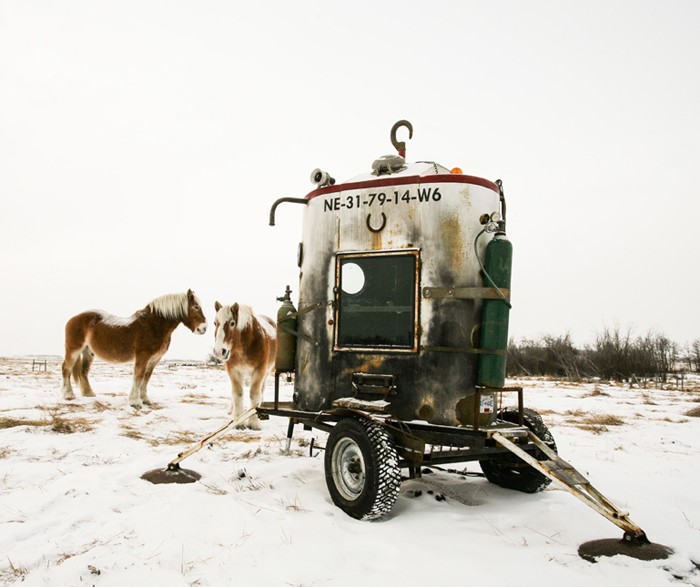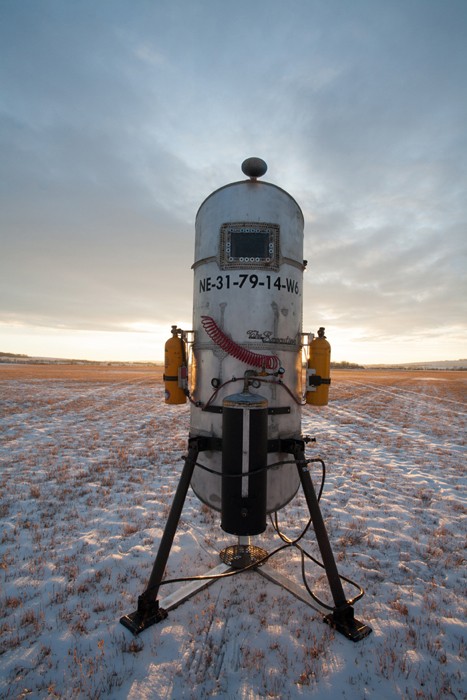David and Goliath
Karl Mattson is quick to point out that his daughter is the sixth generation to live in the family home in Rolla, British Columbia. As far back as 1911 his great-great-grandfather homesteaded on a quarter-section of land north of Dawson Creek. Karl grew up on the farm and as a child played along the creek that runs through the property.
Now that legacy is in danger. For the last six years he has been using his art to fight the effect of what he calls “an aggressive influx of oil rigs” that has set neighbour against neighbour, threatened his family’s health and dramatically altered the nature of the community. “I’ve spent my whole life watching the land here and it really gets to you when you see all the changes,” says the self-taught, multimedia artist. “For years I’ve been dealing with oil companies and the professionals they hire, and I get lost wading around in all the information they send and talk about. Their tactic is to divide and conquer, so that’s why I’m doing the artwork. It gets my message out more than I ever could with my voice. But I’m a lone farmer, so it really is a David and Goliath thing.”

Life Pod—0001, miscellaneous materials and found objects from family farm and the oil and gas industry, 10 x 10 10 feet. Photograph: Karl Mattson. Courtesy the artist.
His art has focused on a series of sculptures he calls “Life Pods;” beautifully awkward objects made from found industrial and farm materials that are also survival chambers, equipped with oxygen tanks and communication devices. The prototype was made from a diesel-fuel tank that he adapted for his small family; there is enough oxygen for six hours, a radio, an air-raid siren and a beacon, and he installed a hook on the top so that a helicopter can lift the pod to safety. Mattson draws attention to the lack of preparedness in the event of an explosion or a major gas-line rupture. The emergency response plan is outlined in a pamphlet that advises local schools to take children into the gym and tape the doors with duct tape; the old nuclear warning, “Duck and cover” has been replaced by an environmental one: “Tape and cower.” Mattson adds, “We’re not even supplied with the duct tape.”
He has made a one-person pod from an airplane-fuel tank called Life Pod – Executive. He took the executive logo from a Winnebego. Lost, an 11-foot-tall voluptuous woman made in 2015 and constructed from scrap iron, has a head made from an old outdoor fireplace that looks like a diving bell. “She has air tanks, a communication device, and I fill her head up with fuel. I’ve lit her up here on the farm a couple of times and she can shoot a 20-foot flame out of the top of her head.” But his bleakest sculpture is Vessel; a life pod in the shape of a coffin. “In 60 years I know I won’t be looking at the stars anymore; I’ll be looking at an orange sky.”

Life Pod—The Executive, scavenged materials from industrial scrapyards and family farm, 10 x 5 x 5 feet. Photograph: Karl Mattson. Courtesy the artist.
There is no small irony in the fact that Mattson makes his objects of resistance out of the equipment and the material used by the industry he is fighting. He has taken a 30-foot-long section of pipeline pipe and built his own flare stack. “Basically, it’s just a giant cannon. I’ve fired it off a few times and it is quite an aggressive piece.” So the battle between his David and the Goliath gas and oil industry continues. In the conflict, Mattson’s slingshot is his art. What is still not clear is whether it will bring down the giant he is fighting.

